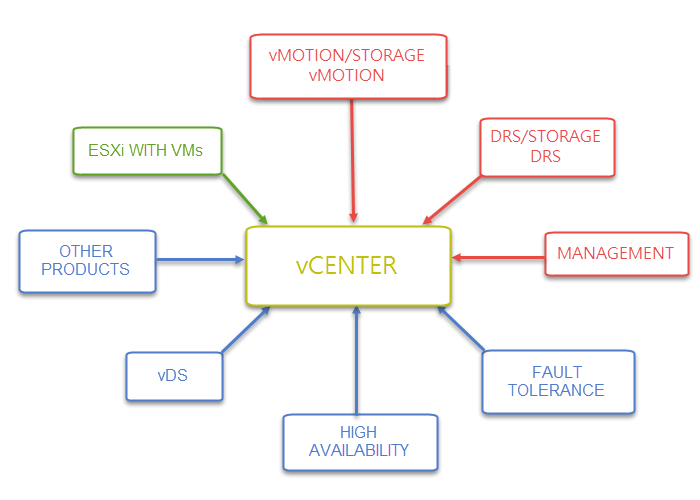Over the past few months, I have seen posts or been asked what happens when vCenter is down. Everybody probably knows that vCenter is a heart of VMware infrastructure installed as Appliance (VCSA) or Windows machine. The main vCenter features are as follows:
- Central management of VMware environments - allows you to manage VM's across multiple VMware hosts at once. E.g. you can create custom roles and permissions.
- Depends on vSphere license, allows you to use DRS/DPM, Storage DRS, vMotion, Fault Tolerance (FT), High Availability (HA) or vSphere Distributed Switch (vDS)
There are also other functions such as easier patching of your VMware infrastructure by integration with the VMware Update Manager component, doing the backup of VMs.
Impact on VMware environment when vCenter is down
Ok, so what happens with above features when vCenter is unavailable? The most important thing is: all workloads (VMs) should be running fine. To illustrate this, the below figure presents features not working (red) or limited working (blue) during the vCenter down.
Central management
Of course, when your vCenter is unavailable, you do not have the central management of your VMware environment. However, still all your VMs are running and if you need to administer them you have to log in directly to ESXi hosts (separately). So if you have 100 hosts and you need to do sth with 10 VMs, you have to log in at least once or max 100 times in the worst case...because maybe you would have to find those VMs 😉
Patching environment
If your vCenter is down, you can't use VMware Update Manager to patch your ESXi hosts. In spite of possibility to patch ESXi hosts using the esxcli command - it may have an impact as you can not do vMotion to migrate VMs between hosts (VMs shut down required).
vMotion and Storage vMotion
vMotion allows moving a virtual machine from one physical server (ESXi host) to another with no downtime. Storage vMotion is a feature that allows the live migration of a running virtual machine's VMDKs from one storage system to another, with no downtime for the VM. These features are available only when vCenter is up (available).
Distributed Resource Scheduler (DRS) and Storage DRS
VMware DRS dynamically balances computing capacity across ESXi hosts (DRS) or between datastores (Storage DRS). As DRS relies on vMotion/Storage vMotion and vCenter calculates a correct balance - DRS does not work when vCenter is down.
Fault Tolerance (FT)
All VMs configured (protected) by FT before vCenter outgate is safe. FT failovers in case of VM fail, however, does not select a new secondary.
High Availability (HA)
VMware HA will restart VMs (powered on before vCenter unavailability) in case of ESXi host failure. As vCenter is responsible for the protection or unprotection of virtual machines - "new powered on VMs" will not be protected by VMware HA until vCenter is back and online. There are not possible to do any changes in HA configuration (e.g. restart priority) as well. Admission Control does not work too.
vSphere Distributed Switch (vDS)
All VMs connected to the vDS still should have network access even vCenter failure. However, if you need to change network settings for VM, you can change only to network in the port group located in vSS. No possible to make any changes in vDS.
Other products
vCenter can be crucial for 3rd applications, other VMware components (e.g. vROps, vRA) or just backup software.
vCenter downtime avoidance
We should limit or totally avoid vCenter downtime (RTO). Fortunately, we can use some availability options:
- Clustering Windows-based vCenter using Windows Server Failover Clustering (WSFC) - RTO ~minutes. Since vCenter 5.5 U2 is possible to build a vCenter cluster.
- Using VMware HA (if vCenter is virtualized) - RTO ~minutes. We should specify the highest priority for the vCenter restart.
- For the smaller environment, VMware Fault Tolerance in vSphere 6 allows to protect VMs up to 4 vCPU - RTO=0.
For more information about vCenter High Availability Options please follow a post here.
Conclusion
vCenter is a crucial component of VMware infrastructure that we should protect. Unfortunately, currently, there are not native vCenter features to protect itself so we have to use mentioned availability options. I hope that VMware adds some additional possibilities in the near future.
Update 09.2016: During VMworld 2016 US, VMware announced some new features in vSphere 6.5. There will be some native replication and monitoring for VCSA as follows:
- Active/Passive HA functionality for vCenter (VCSA only).
- Builtin monitoring web interface for the VCSA.
- Builtin backup/restore of all VCSA configuration.
- VMware Update Manager integrated into VCSA (no Windows required).
